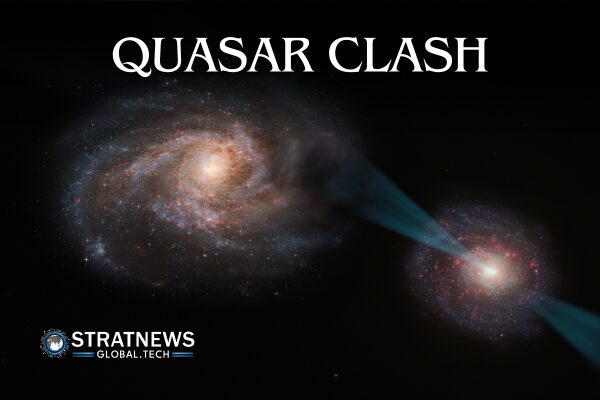Quasar Disrupts Star Formation as Ancient Galaxies Collide
Astronomers have captured a striking scene from the distant past, showing two massive galaxies racing toward each other. Each galaxy holds about as many stars as the Milky Way. This cosmic event occurred when the universe was just 2.4 billion years old—about one-fifth of its current age. Scientists compared the sight to two medieval knights charging at each other in a joust.
These ancient galaxies were observed using two powerful telescopes located in Chile. The light we see from them today began its journey around 11.4 billion years ago. At the heart of one galaxy lies a quasar—an extremely bright and energetic region powered by a supermassive black hole.
A Quasar’s Beam Disrupts Star Birth
The quasar blasts radiation across the electromagnetic spectrum, and this energy has a dramatic impact. It travels into the companion galaxy, hitting gas and dust clouds known as molecular clouds. These clouds usually create stars by slowly collapsing under gravity. However, in this case, the radiation from the quasar fragmented the clouds, forming only tiny, dense clumps too small to produce stars.
“This is the first time such an effect has been seen,” explained Sergei Balashev, an astrophysicist at the Ioffe Institute in Russia and co-lead author of the study.
The intense radiation beam seems to act like a jousting lance, piercing through the companion galaxy and disturbing its ability to form new stars. This vivid comparison was shared by Pasquier Noterdaeme of the Paris Institute of Astrophysics, who also co-led the research.
Supermassive Black Hole Powers the Quasar
The quasar is powered by a supermassive black hole about 200 million times the mass of our sun. As material spirals into the black hole, it heats up and emits energy in two narrow beams. One of these beams is what damaged the star-forming clouds in the neighbouring galaxy.
By contrast, the black hole at the centre of our Milky Way—known as Sagittarius A*—is much smaller, with about 4 million times the sun’s mass.
How the Galaxies Were Studied
The team used two telescopes to study this galactic interaction. The Atacama Large Millimeter/submillimeter Array (ALMA) helped analyse the structure of the galaxies. Meanwhile, the Very Large Telescope (VLT), operated by the European Southern Observatory, was used to examine the quasar and the gas in the other galaxy.
Thanks to their unique alignment, the quasar’s light passed directly through its companion galaxy, allowing scientists to observe the impact up close.
Though galactic mergers are common throughout the universe’s history, this one offers a rare glimpse into an early-stage interaction. The two galaxies are expected to merge fully over time. Eventually, the quasar will quiet down as it runs out of fuel.
“with inputs from Reuters”


